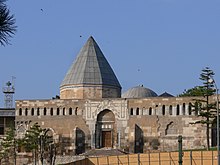Mesud I
| Mesud I | |||||
|---|---|---|---|---|---|
 The Alâeddin Mosque in Konya was built during the reign of Masud I. The building served as the “Mosque of the Throne” for the Seljuq Sultans of Rum and contains the dynastic mausoleum. | |||||
| Seljuq sultans of Rum | |||||
| Reign | 1116-1156 | ||||
| Predecessor | Malik Shah | ||||
| Successor | Kilij Arslan II | ||||
| Died | 1156 | ||||
| |||||
| House | House of Seljuq | ||||
| Father | Kilij Arslan I | ||||
Mesud I', Masud I or Ma'sud I (Modern Turkish: I. Rükneddin Mesud or Rukn al-Dīn Mas'ūd (Persian: ركن الدین مسعود) was the sultan of the Seljuks of Rum from 1116 until his death in 1156.
Reign
Following the defeat and death of his father Kilij Arslan I by Fakhr al-Mulk Radwan of Aleppo at the battle of Khabur river in 1107,[1] Masud lost the throne in favor of his brother Malik Shah. With the help of the Danishmends, Masud captured Konya and defeated Malikshah in 1116, later blinding and eventually murdering him. Masud would later turn on the Danishmends and conquer their lands. In 1130, he started construction of the Alâeddin Mosque in Konya, which was later completed in 1221.[2]
Masud, towards the end of his reign, fought against the armies of the Second Crusade. There were actually two armies, one led German emperor Conrad III and the other led by the French king Louis VII. Masud defeated both of them; the first army in Dorylaeum near modern Eskişehir in 1147[3] and the second army in Laodicea near modern Denizli in 1148.
When he died, Masud was succeeded by his son Kilij Arslan II.
One of Masud's daughters married John Tzelepes Komnenos, a member of the royal house of Byzantium who had converted to Islam.[4]
References
^ Anatolia in the Period of the Seljuks and the Beyliks, Osman Turan, The Cambridge History of Islam, Ed. Peter Malcolm Holt, Ann K. S. Lambton and Bernard Lewis, (Cambridge University Press, 1970), 239.
^ Konya, Julie A. Miller, International Dictionary of Historic Places: Southern Europe, Ed. Trudy Ring, Robert M. Salkin, Sharon La Boda, (Fitzroy Dearborn Publishers, 1995), 381.
^ Martin Sicker, The Islamic World in Ascendancy: From the Arab conquests to the siege of Vienna, (Praeger Publishers, 2000), 77.
^ The Turkish Element in Byzantium, Eleventh-Twelfth Centuries, Charles M. Brand, Dumbarton Oaks Papers, Vol. 43, (1989), 20.
| Preceded by Malik Shah | Sultan of Rûm 1116–1156 | Succeeded by Kilij Arslan II |
This biography of a member of a Middle Eastern royal house is a stub. You can help Wikipedia by expanding it. |
